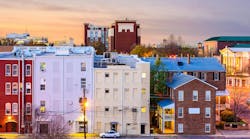More Than Just a Pretty Garden
The University of Pennsylvania has a prestigious reputation for being a leader in education. But bound by the Schuylkill River to the east and south, a growing neighborhood to the west and Drexel University to the north, the university—and the city of Philadelphia as a whole—faces a difficult challenge. The question at hand is, “How does one expand building space to accommodate a growing population while maintaining a balance with the environment?”
When development group University Partners presented a project which could achieve both goals, the university was delighted. Thus, the Radian was born. The Radian is a mixed-use facility with retail space on the first two floors and a 12-level residential tower featuring student apartments above.
One of the more difficult challenges involved in the project was designing a storm water management system to accommodate the city of Philadelphia’s new regulations. By incorporating a green roof, designed by Pennoni Associates Inc. with Roofscapes Inc., the Radian was able to meet these updated requirements and provide a state-of-the-art community resource to the university.
Going Green
Green roofs consist of a traditional roof structure but also have a drainage layer with a vegetative layer on top. These layers are separated from traditional materials by a layer that is waterproof and repels roots. Green roof systems are already a popular technology in Europe, but they are just starting to take hold in North America.
Green roofs have many beneficial qualities, the most visible of which is a positive aesthetic look. In an urban setting, gardens and green space are often sparse, but many residents of the Radian will be able to look out their windows and see just that. And because the building’s green roof is located on the mezzanine level above the planned retail shops, it will serve as a place where both consumers and residents can relax.
On a hot summer day, the concrete sidewalks, brick buildings and asphalt paving radiate the sun’s heat, making urban areas hotter than the air temperature would indicate. Green roofs are able to reduce the heating of buildings. Their vegetation absorbs the sun’s energy, thereby protecting the underlying roofing system while providing a cooling effect on the environment. Other benefits of green roofs include improved air quality, a natural habitat for wildlife and a savings in energy costs.
Storm Water Control
Another benefit the green roof brings to the Radian is an improved storm water management system. On Jan. 1, 2006, the Philadelphia Water Department instituted new storm water management regulations, providing certain guidelines for achieving water quality and storm water runoff rate control. By using a green roof design, the Radian is able to exceed the guidelines and improve the overall quality and uniqueness of the building.
The green roof is an effective tool in reducing the volume and velocity of storm water runoff from roofs. Much of the storm water that will fall onto the building’s roof will be detained by a vegetative layer. Many of the plants will also store rainwater to sustain themselves; eventually, they will pass the water back into the atmosphere through evaporation. And while the water is being detained by the plants, the peak volume of storm water running to the Radian’s basins is reduced.
Of the 1.6-acre site on which the Radian will be built, 17 percent of it will be dedicated as green roof space. To pass the new regulations set forth by the Philadelphia Water Department, however, the impervious surfaces had to be reduced by 20 percent over the existing condition. To meet this requirement, designers of the Radian took a unique approach. An additional 6 percent of the site will drain onto the green roof from adjacent roofs, reducing the total impervious surfaces to the required level.
Management System Design
Due to the owner’s desire to maximize tenant space on the first two floors, little space was available for a storm water management system, which otherwise may have included storm water tanks. Even with the 20 percent reduction in impervious surfaces that the green roof provided, regulations required the remaining impervious surfaces still be managed for storm water runoff. Regulations also required that any underground storm water management basin had to be at least 10 ft from any existing and proposed buildings.
Therefore, the only logical place for such a basin would be either the courtyard entrance in front of the building or the driveway to the loading dock behind the building. Project leaders decided to construct one basin at each location to avoid having to pipe storm water from either space through the building.
Each basin is responsible for detaining and releasing half of the site’s storm water at a controlled rate. Since most of a site’s storm water pollutants are washed away within the first inch of rainfall, the basins were designed to detain the first inch of storm water on site for water quality. That way, the pollutants could settle out and collect within a basin. The basins were also designed to control the peak rate of flow at which storm water from the site enters the city’s sewers.
In addition to the green roof, other design elements will be incorporated at the Radian to further manage the site’s storm water. Trees are planned for the streetscape and courtyard. Pervious pavers are also being installed along the western walkway entrances to the building and along a portion of the street sidewalk. Porous pavement will make up 3 percent of the site, and sand will be laid beneath the walkways to improve the pavement’s permeability.
Award Recognition
By using a green roof design, regulations were met and a building design for use within the University of Pennsylvania community was improved. Green roofs may not be as popular in the U.S. as they are in Europe, but their reputation is on the rise.
In fact, the Philadelphia Water Department’s Office of Watersheds group recognized the project with an award for storm water best management practices. The Radian, designed by project architect Erdy McHenry Architecture, is scheduled to open in August 2008.
Download: Here

